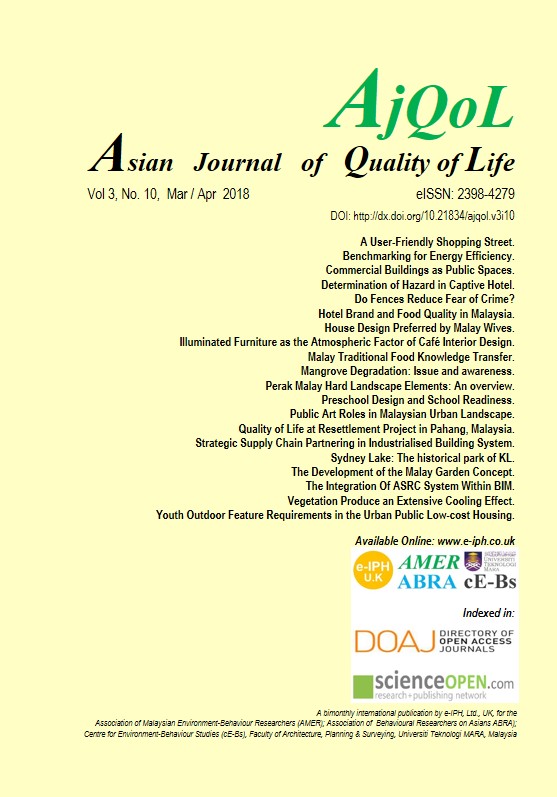Strategic Supply Chain Partnering in Industrialised Building System
Main Article Content
Abstract
The purpose of this paper is to explore the concept of supply chain partnering practiced in Industrialised Building System. The relationship was based on the elements of trust, share a vision, decision-making and continuous improvement. The methodology adopted used quantitative and qualitative approach. Outcomes of the results, the public clients point out on the element of trust in between contractors were based effectiveness of communication. Meanwhile, the private client indicates competence of work as a successful element of trust in supply chain partnering in Industrialised Building System.
Metrics
Article Details
License
Copyright (c) 2018 Faridah Muhamad Halil, Mohammed Fadhil Mohammed, Rohana Mahbub, Ani Saifuza Shukur

This work is licensed under a Creative Commons Attribution-NonCommercial-NoDerivatives 4.0 International License.
References
(CII), Construction Industry Institute. (1991). In search of partnering excellence. (Special Publication No. 17-1). Retrieved 30/3/2010, from Report by the Partnering task Force of CII, Austin, Texas
Baden-Fuller, C. (1995). Strategic Innovation, Corporate Entrepreneurship and Matching out-side-in to Inside-out Approach to Strategy to Strategy Research British Journal of Management, 6(3), 3-17. DOI: https://doi.org/10.1111/j.1467-8551.1995.tb00134.x
Bayramoglu, S. (2000). Partnering : Applicability in the Turkish Construction Sector. Istanbul Technical University.
Cartlidge, Duncan (Ed.). (2009). New Aspects of Quantity Surveying Practice. United Kingdom: Butterworth-Heinemann.
CIDB. (2006). Industrialized Building System in Malaysia. In I. E. Ismail, I. N. Bahri, R. Ahmad & S. N. Aziz (Eds.), (pp. 3-19). Kuala Lumpur.
Che Bond Ahmad, Izzarul Hafni Mohd Hashim, Jamalunlaili Abdullah and Jasmee Jaafar. (2012). Stakeholders' Perception on Buffer Zone Potential Implementation: A Preliminary Study of Tasek Bera, Malaysia. Social Behavioral Science, 50, 582-590. DOI: https://doi.org/10.1016/j.sbspro.2012.08.061
Cook, E. L., & Hancher, D. E. (1990). Partnering : Contracting For The Future. Journal of Management in Engineering, 6 (4), 431-446. DOI: https://doi.org/10.1061/(ASCE)9742-597X(1990)6:4(431)
Cowan, C., Gray, C., & Larson, E. (1992). Project Partnering. Project Management Journal, XXII, 5-11.
DeMarrais, Kathleen, & Lapan, Stephen D. (Eds.). (2004). Foundations for ResearchMethods of Inquiry in Education and the Social Science. London: Lawrence Erlbaum Associates. DOI: https://doi.org/10.4324/9781410609373
Gidado, K. I. (1996). Project Complexity: the Focal Point of Construction Production Planning. Construction Management and Economics, 14, 213-225. DOI: https://doi.org/10.1080/014461996373476
Holmen, Elsebeth, Pedersen, Ann Charlott, & Torvatn, Tim. (2004). Building relationship for technological innovation. Journal of Business Research, 58, 1240-1250. DOI: https://doi.org/10.1016/j.jbusres.2003.10.010
Hook, Matilda, & Stehn, Lars. (2008). Lean principles in industrialized housing production:the need for a cultural change. Lean Construction Journal, 20-33.
Jones, Keith, & Kaluarachchi, Yamuna. (2007). Operational Factors Affecting Strategic Partnering in UK Social Housing. Engineering, Construction and Architectural Management, 14 (4), 334-345. DOI: https://doi.org/10.1108/09699980710760658
Larson, E. (1995). Project Partnering : Results of Study of 280 Construction Projects. Journal of Management in Engineering, 10 (2), 30-35. DOI: https://doi.org/10.1061/(ASCE)0742-597X(1995)11:2(30)
Lazar, F. (2000). Project Partnering: Improving the likelihood of win-win Outcomes. Journal of Management in Engineering, 16(2), 71-83. DOI: https://doi.org/10.1061/(ASCE)0742-597X(2000)16:2(71)
Mosley, D., Moore, C., Slale, M., & Burns, D. (1991). Partnering in the Construction Industry: Win-Win Strategic Management in Action. National Productivity Review, Summer, 319-325. DOI: https://doi.org/10.1002/npr.4040100305
Pheng, Low Sui. (1999). The Extension of Construction Partnering for Relationship Marketing. Marketing Intelligence and Planning, 17(3), 155-160. DOI: https://doi.org/10.1108/02634509910271614
Rahman, M. Motiar, Asce, M., & Kumaraswamy, Moham M. (2004). Contracting Relationship Trends and Transitions. Jounal of Management in Engineering. DOI: https://doi.org/10.1061/(ASCE)0742-597X(2004)20:4(147)
Taylor, Bill, sinha, Gautam, & Ghoshal, Taposh (Eds.). (2006). Research Methodology
A Guide for Researchers in Managemnet and Social Sciences. New Delhi: Prentice Hall of India Private Limited.
Wong, P. S. P., & Cheung, S. (2004). Trust in Construction Partnering : Views from Parties of the Partnering Dance. International Journal of project Management, 22, 437-446. DOI: https://doi.org/10.1016/j.ijproman.2004.01.001




